#ferelden design
Text
Andrastian Statues
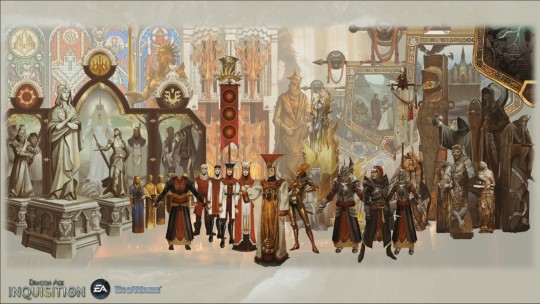
The purpose of this collection of statues is to show the Andrastian style depending on the region, the details in it, and how this may or may not influence other statues we saw in game. I also attempt to recollect some interpretations of them, although most of them are mostly based on speculations.
The current post contains the following set of statues:
Ferelden Style: Pre-Divine Andraste, Chasind Andraste, Ferelden warrior protector Andraste, The Maker, The Dwarf [?], Rider Maferath [?], Masferath Repentant, Hanged Masferath, Other Statues.
Orlesian Style: Rustic Maferath, Hessarian, Andraste; The Orlesian Warrior Andraste, The Stylised Orlesian Andraste, The Orlesian Andraste, The Orlesian Maferath, The Orlesian Havard, and the Orlesian Hessarian; The Weight of War
Free Marches Style: The Free Marches Hessarian, The Free Marches Andrastian Warriors [?]
Unknown Style: The Skull with sword, The Guide, Guardians of the Path / The Watcher.
[This post belongs to the series “Analysis and speculation of Statues”]
Ferelden Style
Pre-Divine Andraste
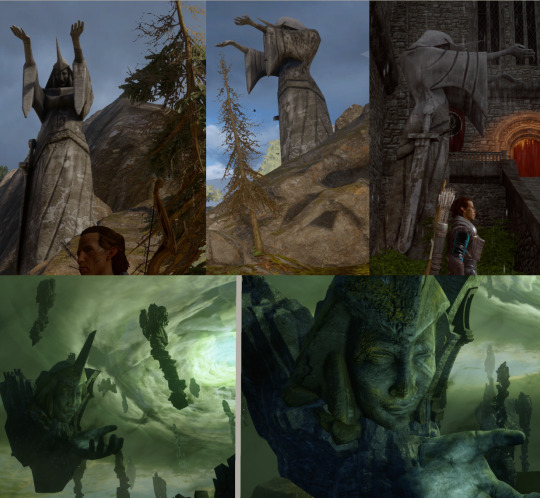
One of the most iconic statues in DAI.
It’s present all over Ferelden, specially in big, colossal statues along the paths of Hinterlands. They are so big that sometimes one can overlook them unless you look upwards [check Hinterlands: Statues, paintings, and structures found in the open].
In Skyhold, we can find this statue in a small version in the local chapel, which triggers the note Bride of the Maker.
Thanks to the DLC Jaws of Hakkon [Main Chamber of Razikale’s Reach], we know that this statue belongs to a pre-divine time. It is probably one of the oldest representations of Andraste we have in-game.
As usual, she has a one-spike helm that has strong resemblances to Flemeth’s tiara, and to Humanoid Mythal statue, Dragon Mythal statue, and the Ferelden Wyvern.
She has a sword in her hip.
Her sleeves and skirt have long lines that emulate folding. It’s a style we saw in statues that were considered “elvhen” in-game [for example, the Elven Archers or The guide]. But we can see this became an Andrastian style since we also see it in the Blocky bearded humanoid.
Her gigantic hands have been used in several elvhen places, and I wonder how meaningful these are: these hands appear in Exalted Plains: the Dead Hand as well as in the Shattered Library, holding eluvians. Is this a mere reuse of resources or hides some lore in it? We know DAI is less lazy about this than previous games.
This statue is curiously aligned with Humanoid Mythal statue in the Fade, as well as with the Imperial Highway Columns [check The Raw Fade: Part 1]. A Design choice that keeps me wondering if it hides some meaning in it.
Chasind Andraste
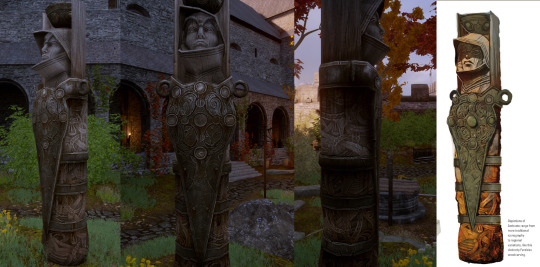
It has the design of a totem.
Its relief is very intricate.
She is represented as a protector warrior due to the strong presence of the shield on it.
We can suspect this statue is also ancient, and you can see that it has similar style to the Alamarri Monolith with swirls we find all over Hinterlands.
If you pick the Chantry-related garden in Skyhold, this statue appears in it and the archivist Banon will mention details about it in The Women of All War. He claims it’s Chasind, not original from Skyhold, brought by Ferelden into the castle. He also suggest it’s a re-usage of an ancient totemic statue.
This last comment streghtens the idea that ancient Andrastian art tends to be done over or using/co-opting statues from previous civilisations.
Ferelden warrior protector Andraste
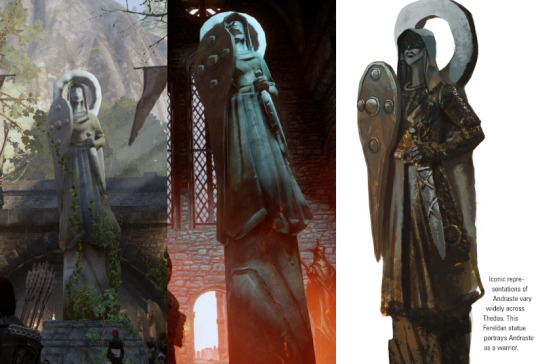
Another classic representation of Andraste in game.
It’s Ferelden style.
She is represented as a warrior [holding shield and sword] but also as a divine entity [I suspect the ring behind her works as a rustic design of a halo].
There is a chance that the thick “halo” could be an adaptation from another icon we saw among the Elvhenan design: the Golden Ring. How is this possible? I think it’s not too strange considering how deeply related to the elves the Avvar are. If we think that part of this culture comes from the Alamarri, one could guess that through the elvhen lover that Thrydda had, some elvhen presence has been around this culture to incorporate elvhen iconography in their own art, translated later into something of this shape.
The Maker
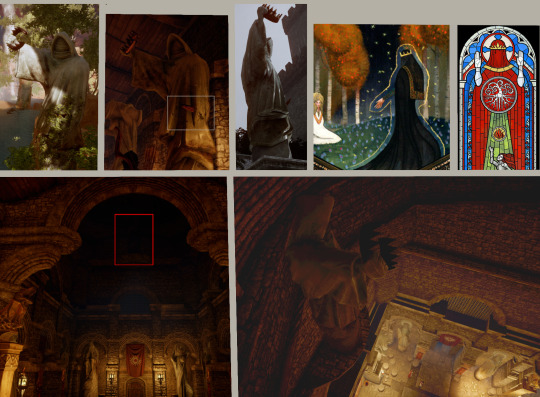
This mysterious figure has no face, in fact, it looks like bandaged. In his right hand holds a crown, while in his left hand, a dagger. The outfit is a very simple robe.
The dagger is quite curious for a representation of the Maker.
This statue took me a long whlie to identify. In early posts I kept calling it Faceless figure holding a crown. I came to the conclusion it is the Maker.
This statue appears always within the context of the Andrastian statues, so it could not be asumed in any other way than related to the Andraste Myth. In the posts Andrastian Design: Stained Glasses and Andrastian Design: Tapestry and Tryptich, we can see that a figure with no face and wearing a crown of similar characteristics is represented as the Maker. These are my main arguments to be confident about this identification.
In Hinterlands, he appears in the main hall of Haven very high upon the hall, hidden in the shadows, in a room filled with andrastian iconography, which reinforces the idea that it represents an entity that is above all of them, Andraste included. Another confirmation of being the Maker.
It also appears in the Tyrdda Bright-Axe Path, which has a mixture of statues, and in Forbidden Oasis, when the place was took by the Andrastian forces. It also appears in the mysterious Hinterlands: The Unknown Ruin. Other more natural and Andraste-related places where we find it: Redcliffe - Future, Therinfal Redoubt, Western Approach: Adamant Fortress.
The Dwarf [?]

This figure was tag along the blog as Blocky bearded humanoid. It is found in the main hall of the Templar building of Therinfal Redoubt and in the corridors of Redcliffe - Future
The design of this statue feels closer to the pre-divine Andraste. Maybe it has some influence of the Alamarri style.
The long lines on sleeves and chest seem to suggest similarity in style with the pre-divine Andraste but also with the elvhenan statues such as the Elven Archers, or The guide.
Its face seems to show a big smile, but if you see it with more detail, it may also represent a long, long beard. The broad constitution, the big ears, the lack of hair, and the prominent beard seem to suggest a golem-like or dwarven representation.
I can’t say I can identify this figure in the Andrastian Myth, but it’s related to the Andrastian Faith since it appears where there are other andrastian figures.
If this figure comes from the Alamarri and it was co-opted by the Andrastian faith, I could suspect that may be related to the dwarven culture that Alamarri had. If we remember Tyrdda Bright-Axe Path, she had a child with a dwarven prince. The Chasind also had mixed descendants of humans and dwarves. So, if it’s an alamarri statue co-opted by the Chantry, it could not be strange for it to be a dwarf. These details may indicate that the Alamarri had a deeper relationship with not only elvhen, but also dwarves, and this aspect appeared in the art until co-opted by the andrastian faith resulting in this figure.
Rider Maferath [?]

This statue appears only in Fallow Mire. Although, the same statue appears riding a horse in Crestwood: surface. Maybe it’s a mere reuse of resources.
It has a similar design to the Blocky bearded humanoid.
It represents a man with a beard, and its angular design may suggest similar time and style than the previous one.
More details in the section Other Statues from this post.
Masferath Repentant

Mostly seen in the region of Ferelden [although, you can find it too in Western Approach: Adamant Fortress]
This is the typical Ferelden statue of Masferath, regretting his betrayal.
He is sitting on a stone which has a design of a snake surrounding it, representing the Tevinter influence or deal he made with the Archon before handing over his wife.
The helm in this statue has a C-shape, which I find very similar in design to the Tevinter helms [check section “Outfits” in Patterns and Styles: Tevinter]. I’m not sure if this is mere coincidence, or it speaks of a common [dragon-inspired] origin source.
Hanged Masferath
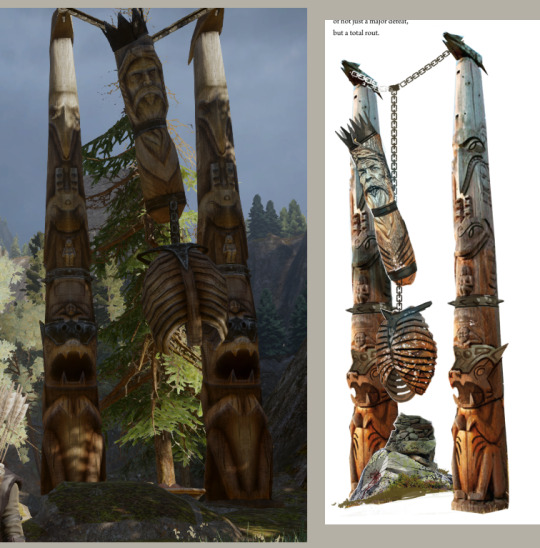
This totemic sculpture can be found in Hinterlands: Statues, paintings, and structures found in the open.
This is a Ferelden representation of Masferath being hanged. Clearly Ferelden has a strong sentiment with his betrayal.
The totemic structure seems to show mabaris at its base, followed by two different kinds of birds or maybe it’s a dragon [hard to say].
The top of these totems keeps bringing my attention: I can’t stop thinking there may be some link with the Tevinter metallic statue that I called “Tevinter bird”, found in Ferelden in the underground region of Crestwood: Flooded Caves.
Other Statues
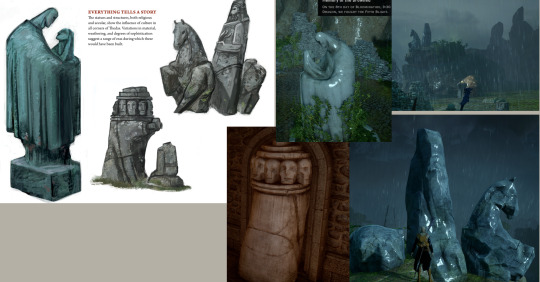
The couple can be found in Hinterlands: Redcliffe - Present, as a symbol to remember those who died in DAO-Redcliffe. It can also be found in Crestwood: surface as a memory statue of the drown, and in Frostback Basin [DLC]: Nigel’s point, as a memory statue of Ameridan’s friends: The templar Haron and the dwarf Orinna. It feels more like a reuse in most cases since it’s a strange statue to represent "fallen/lost people”. Certainly we can assume it’s Ferelden made.
The horse with the rider seems to have, as we see in its drawing from the book Art of Inquisition, a lot in common with the previous statue I called “Rider Masferath”. The horse has been removed in some other places to only let the human figure stay. It can be seen in Fallow Mire without his horse, and in Crestwood: surface. Sometimes the rider is not well chiselled in the stone.
The vessel with many faces is only seen once in the game, in the The Darvaarad - Part2. We know the Qunari took this castle and put a lot of statues that they gathered around the world. However, this statue of many faces looks like it belonged to the inner corridors of the castle, implying the castle per ser may have been Ferelden, or elvhen in origin, but repurposed by Ferelden later. In the game we only see the “back” part of it, while in the book Art of Inquisition, we can see the full statue, which implies a beheaded figure. Maybe it’s the representation of a jury. It could also be interpreted as an entity that puts “the right head” into the people, suiting the Qunari and their Qun philosophy, but this interpretation would make me question why it is so related to Ferelden art in the Art Book.
Orlesian Style
Rustic Maferath, Hessarian, Andraste
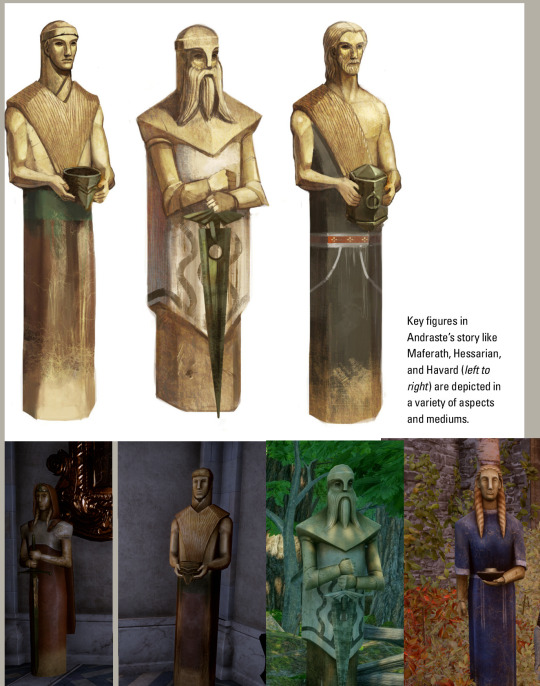
A bit distant to the style of the Blocky bearded humanoid, we have these series of statues representing typical characters from the Andrastian Myth.
They are mostly located in different areas all over Orlais [or inside the Skyhold if you pick an Andrastian garden].
We find Andraste, in blue and red [I’m assuming one is the bride of the Maker, while the other is the warrior protector of her people]
Masferath is carrying a crown (?) in his hands, and Hessarian is holding the Sword of Mercy.
These seem to belong to an Orlesian style but rustic or more “popular”. They give me the impression that were made by the working class people who could not afford realistic artists to sculpt them in stone.
They seem to be made out of wood.
The Orlesian Warrior Andraste

Unlike the previous one, this Orlesian statue is made out of stone and is bigger, more detailed, and realistic. It seems to appear in rich/high class places.
It also appears in Emerald Graves: Din'an Hanin, which may represent the influence of the Andrastian faith among the Ancient Dalish when the Dales was their Kingdom land granted by Andraste herself.
This statue presents Andraste as a warrior: she is wearing a detailed armour, a big sword, and, curiously, a helm that has no iconic single-spike. However, I can see some similarities in the armour design to Flemeth’s armour or the armour used by Humanoid Mythal statue.
Due to the strong similarities in style, this statue belongs to the same group than the Orlesian Andraste, Orlesian Maferath, Orlesian Havard, and Orlesian Hessarian.
The Stylised Orlesian Andraste

Another over-detailed statue of Andraste made out of Stone which appears in wealthy places.
The whole design of Andraste has a strong similarity to Tyrdda Bright-Axe, which may suggest that this statue may have a strong alamarri influence, mixing Andraste tale with the representation of Tyrdda.
The icon that represents the sun, ironically, has a strong similarity with the statue I called Sun-head creature, deeply related to the Elvhenan and, potentially, to Tevinter and its old dragon gods. This may imply that this statue may have collected several icons and details from different cultures and faiths to gather them in the cult to Andraste. This process is well known in human History, where the forced religion tries to blend with the local ancient one to produce an assimilation of the new faith.
The Orlesian Andraste
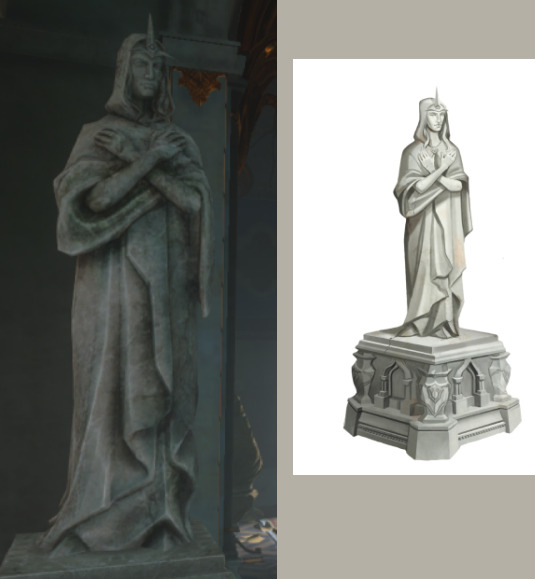
This Orlesian statue is made out of stone and is bigger and a lot more detailed and realistic that the “wooden” sculptures.
It tends to appear in wealthy places as well as inside the Chantries of the game.
It represents mostly the divine Andraste and the bride of the Maker, without any element of her warrior side.
She has a one-spike helm that has strong resemblances to Flemeth’s tiara, Humanoid Mythal statue, Dragon Mythal statue, and the Ferelden Wyvern.
Due to the strong similarities in style, this statue belongs to the same group than the Orlesian Warrior Andraste, Orlesian Maferath, Orlesian Havard, and Orlesian Hessarian.
The Orlesian Masferath
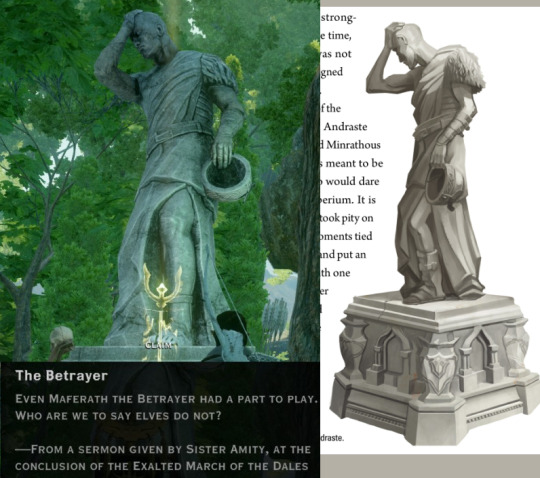
It is called “The Betrayer”.
We see the man worried, grabbing his own head, showing the weight of his own betrayal. He keeps the crowd of his leadership of the Alamarri in his hand since the Chantry tale says that he betrayed Andraste out of jealousy because she was more important than him among their people. I always questioned this since he was the one commanding the armies and their people into Tevinter, and he may have chosen the “lesser bad” option [read the The Chantry and the Mythology of the Chant of Light for more details].
Due to the strong similarities in style, this statue belongs to the same group than the Orlesian Warrior Andraste, Orlesian Andraste, Orlesian Havard, and Orlesian Hessarian.
The Orlesian Havard

Havard is shown here with avvar clothings [fur-based].
He is carrying the urn of Andraste’s ashes that will be placed in Haven and will become later the Temple of Andraste [DAO].
We know thanks to the notes triggered in it that this statue seems to represent Havard but its appearance was based on a noble’s lover [check it in Emprise du Lion: Pools of the Sun].
Due to the strong similarities in style, this statue belongs to the same group than the Orlesian Warrior Andraste, Orlesian Andraste, Orlesian Maferath, and Orlesian Hessarian.
The Orlesian Hessarian

He is holding the sword that will be called the Sword of Mercy, used to kill Andraste in the pyre so she could not suffer anymore.
His hat has a bent T-shape that we can see in many other helms of Tevinter warriors in the section of “outfits” in Patterns and Styles: Tevinter.
Due to the strong similarities in style, this statue belongs to the same group than the Orlesian Warrior Andraste, Orlesian Andraste, Orlesian Maferath, and Orlesian Havard.
The Weight of War

This statue was tagged in this blog as Man holding bigger head for a long while.
It has appeared in Forbidden Oasis, Redcliffe - Future, and in Orlais: Winter Palace.
Thanks to the constant presence of Andrastian-themed art around it, I could finally assume that this statue belongs to Andrastian art in Orlesian style.
The main man has angular features, his ears are not visible since it looks like he is wearing a chain-mail. He uses scale-based pauldrons, and a robe. He is holding a sword with one hand while the other holds a bigger head. By comparison with the state of the overall figure, we can assume that the bigger head has a lot of wounds and scars [meaning that this is part of the sculpture design and not a consequence of erosion].
Despite looking similar, the head in his hand and this man’s profile are different. The bigger head has a smaller, shrank nose.
The only significant shape in this statue that can give us a resemblance of a hint to whom it belongs is his belt, which has pointy ends. We had seen this pattern in two places: in Tevinter artefacts, such as the sacrificial burial, or in andrastian outfits.
It triggers a codex called The Weight of War which is a bit unreliable, since the person explaining this is an amateur historian, but it’s the only hint we have about this statue. The amateur historian implies that this statue may belong to a warrior with a philosophy similar to the Grey Wardens.
More details about this statue in the post Forbidden Oasis.
Free Marches Style
The Free Marches Hessarian
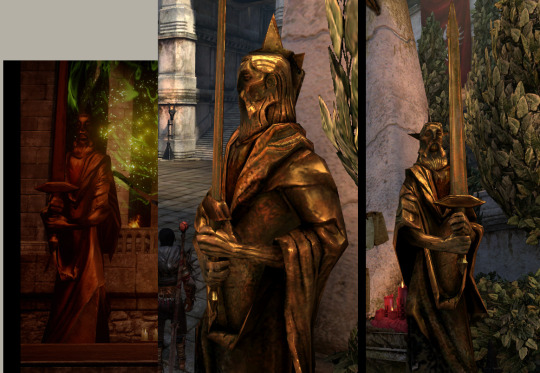
It appears mostly in the Templar fortress of Therinfal Redoubt
This statue has a strong resemblance to Tevinter art. It’s not only the dark metallic material used for the sculpture, which was strong similarities with Tevinter artefacts such as Thrummer, Water dispenser, Tevinter urn, Tevinter artefact with spikes, Tevinter golem or Claw of Dumat, but also the prominence of angles and pointy ends.
There is no codex associated with this sculpture, but I can guess it may represent Hessarian [the main Tevinter figure in the Andrastian Myth] since this statue has a version carrying a sword.
It has a long beard and hair.
This statue has also been present in DA2, specially in the Chantry district of Kirkwall [check it in Architecture of Kirkwall : The Chantry].
The Free Marches Andrastian Warriors [?]

It appears mostly in the Templar fortress of Therinfal Redoubt and in the Fade.
This statue has a strong resemblance to Tevinter art. It’s not only the dark metallic material used for the sculpture, which was strong similarities with Tevinter artefacts such as Thrummer, Water dispenser, Tevinter urn, Tevinter artefact with spikes, Tevinter golem or Claw of Dumat, but also the prominence of angles and pointy ends.
It’s wearing a typical DA2 Andrastian robe, but the helm has always brought my attention: it has a lot of more similarity to the Tevinter warriors than to the one-single spike helm of Andraste.
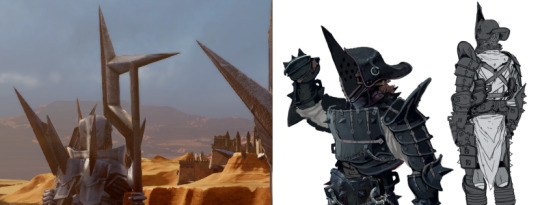
Its weapon also has a strong similarity to the weapon used by Tevinter golems, while its helm has strong similarities with the ones that belong to the Tevinter warriors. One may say that both of them, in fact, are representing the one-spike helm of Andraste.
The unmistakable identification with Andrastian faith is given by the robe: if we see the chest, we will see the pointy half sun on it, which was the main design of the outfit of Elthina and other chantry priests we saw in DA2.
Unknown Style
The Skull with sword
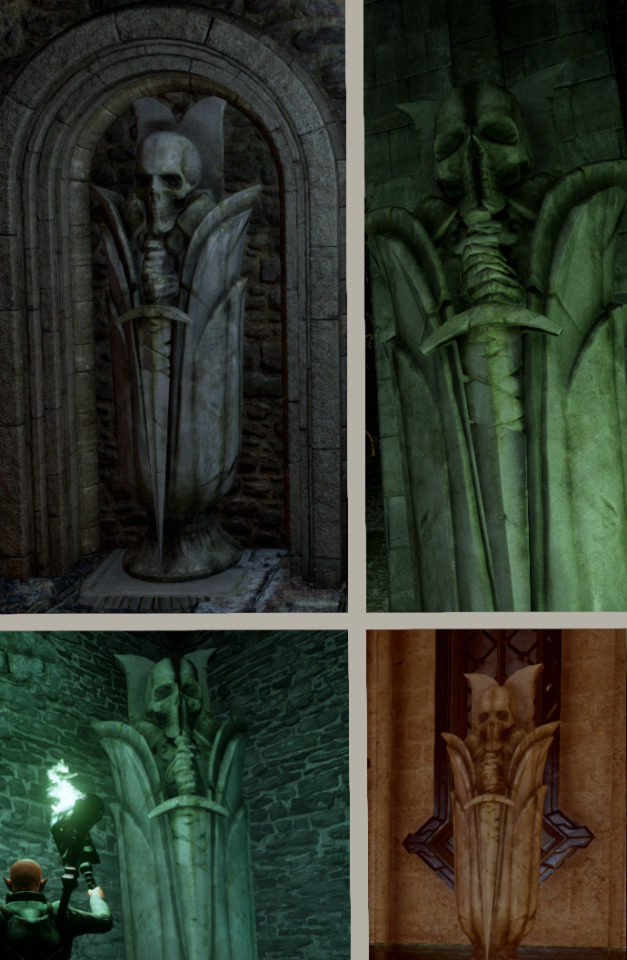
This is the statue that I called Skull bud with sword all over this blog.
The skull is quite long for a regular human. It holds a sword. The body seem to be inside a bud or a shell that may look like a flower bud but also as the shell of an insect/scarab.
This statue has always appeared within Andrastian contexts such as in Frostback Mountains - Haven [the basement], Hinterlands:Dead Ram Grove, or Ferelden: Therinfal Redoubt, but also in places where the Andrastian context is not that strong, but still yet reasonable to appear, for example in Hinterlands: The Unknown Ruin [overtaken by Andrastian faith lately, so far we see in the statues present in this room], or Emerald Graves: Din'an Hanin [which clearly shows how the Ancient Dalish allowed a certain level of assimilation of the Andrastian faith thanks to Andraste’s gift of the Dales]. However, we also find this statue in Western Approach: The Still Ruins, Viridis Walk and Inner Sanctum, which is a pre-blight Tevinter building, so one is inclined to think that this statue may have been Tevinter in origin, and somehow, adopted later by the Andrastian faith. Or maybe it’s just Elvhenan, taken first by Tevinter, and later by the Chantry [as we see this pattern repeats over and over with everything related to Tevinter].
One of the potential interpretations is that this sculpture represents a coffin, or a dead who is put to sleep in this position. The fact that this skull is inside a bud or an insect shell [in addition to the speculation that, like all what comes from Tevinter, was originally elvhenan] brings the possibility of being related to Uthenera and the mysterious codex of Vir Dirthara: A Flowering Imago that I tried to multi-interpret in several ways in Ancient Elven codices; Vir Dirthara.
So far I know, there is no codex associated with it, and we have only speculations about it.
Its style is not strongly similar to all these Andrastian statues, but the fact that it appears mostly within andrastian themed rooms, it’s hard not to bring it into this post.
However, I’m not confident about how to understand this statue and to what culture associated it with.
The Guide


It can be seen in three places only: Emerald Graves: The open pointing more or less towards Elgar’nan’s Bastion, on top of Stone-Bear Hold Avvars - Part 2 pointing out to the sea, and in the Fade, exactly in Flemeth’s Fade: Part 2, pointing the path towards Mythal/Flemeth.
It’s associated with the unreliable landmark called The guide [written by this orlesian scholar who lacks of deep knowledge of elven culture], which identifies it as an elvhen statue, but it has a lot of style similarities to the Blocky bearded humanoid and the pre-divine Andraste as well as to the Skull bud with sword. If we see the back of an Elven Archer statue, we can find line-based similarities too, so it’s hard to decide whether this is truly Elvhen in origin and co-opted by the Andrastian and repurposed later, or it truly belongs to the set of pre-divine statues we spoke above and this amateur scholar misunderstood it as Elvhenan.
The unreliable landmark links it to Falon’Din for the mere fact that it is pointing out a place, so it “guides”. If we overlook this pathetic logic, and we give it a remote chance for it to be elvhen, we should be careful to identify it with Falon’Din. First, Via Solas, we know that Falon’Din was far from guiding people [Check Evanuris], and second, even if we consider this statue to be Falon’Din, we should never forget how Falon’Din and Dirthamen are entangled one another [check Humanoid Dirthamen], so this could also be a statue representing Dirthamen. The shape of the sleeves has some resemblance to the Elven Owl statue [they have long lines along it], but once more, both gods are so indistinguishable one another that it’s hard to say who is who.
Guardians of the Path / The Watcher

This hooded statue was called Humanoid Dirthamen/Falon'Din in this blog.
The hooded statue can be seen in four places: in Emerald Graves: The open, as a watcher of entrances, in the Hinterlands, along the Tyrdda Bright-Axe Path inside the Calenhad’s Foothold; in Exalted Plains: Northern Ramparts and Citadelle du Corbeau, as the main big statue when you step into the Citadelle [again, watching over an entrance] and in Flemeth’s Fade – Part 2, as a statue bleeding profusely with a sword in its back, as an unmistakable symbol of betrayal.

In all these cases, the hooded version of the statue seems to be related to “watch or protect entrances”. Due to its presence in the Fade of Flemeth, we also can associate it with deep betrayal.
Once we see how the pattern unfolds with the statue I called Humanoid Dirthamen/Falon'Din [hodded version] we can understand the Andrastian version “guardian of the path” in similar fashion [he always appears in entrances as well], suspecting it was a re-usage and co-opt of the elvhen hooded statue when the Andrastian forces conquered the Ancient Dalish's lands.

The Guardian of the Path appears twice in game: in Crestwood: surface, at the entrance of the region, similar position as the hooded versions in Emerald Graves, and in the entrance to the region of the Exalted Plains.
#andrastian design#andraste#The Guide#guardian of the path#Skull bud with sword#Man holding bigger head#orlesian design#ferelden design#Humanoid Dirthamen/Falon'Din#andraste statue#hessarian#havard#Maferath#blocky bearded humanoid#Faceless figure holding a crown#the maker#maker#Analysis and speculation of Statues
15 notes
·
View notes
Photo

i am the one who will live on
etmeres mahariel | sterling hawke | glendimar lavellan

#old version under the cut#dragon age#dragon age: origins#dragon age 2#dragon age: inquisition#hero of ferelden#warden commander#mahariel#etmeres mahariel#champion of kirkwall#hawke#sterling hawke#inquisitor#lavellan#glendimar lavellan#character design#my art
1K notes
·
View notes
Text
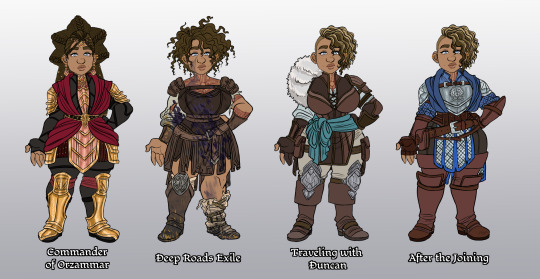
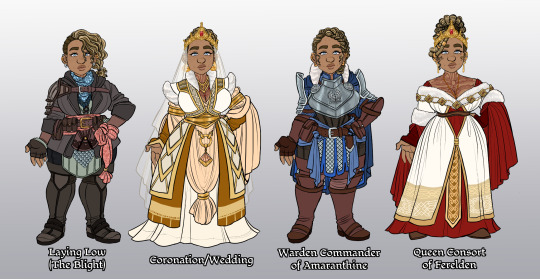
Finally finished! Alana's outfits are wicked detailed, lmao
I am, as ever, in love with doing "paper doll" outfit designs
Re: her queenly outfits, I figured that she would make a point of wearing Alistair's family colours, but make sure her details are Orzammar-derived rather than strictly Fereldan; their entwined houses are both strongly represented in their marriage to present a united front
759 notes
·
View notes
Text
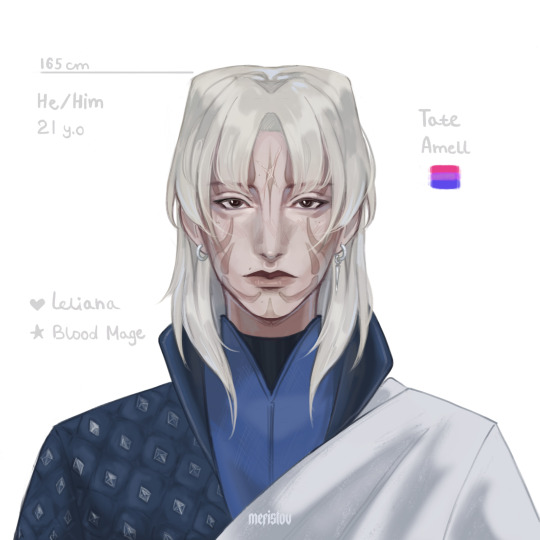
I've been thinking a lot about DAO lately and realized that I've never drawn my HOF's, so I have to fix it. This is my baby Warden 🤲🏻🥺 He is a bit creepy and weird but I love him.
(I want to replay dao and I wonder if this old ass game will run on my new gaming pc...)
~
Commissions : Open
#hero of ferelden#dragon age#dragon age origins#bioware#grey warden#warden amell#m!warden#warden x leliana#da: o#fantasy art#my art#illustration#character art#character design#oc#artists on tumblr#artwork#commissions are open
88 notes
·
View notes
Text

My dragon age women
Asher Surana (Hero of Ferelden) - Raine Hawke (Champion of Kirkwall) - Nolwyn Lavellan (Inquisitor/Reluctant Herald of Andraste)
#dragon age#dragon age inquisition#oc#art#original character#design#character#dragon age 2#dragon age origins#Lavellan#Hawke#fem hawke#hero of ferelden#blight#warden
48 notes
·
View notes
Text
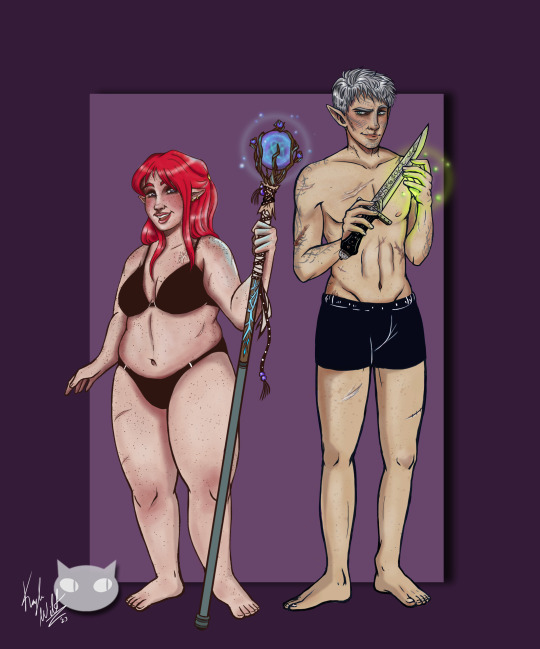
This was supposed to just be a "body type" study...oops.
I regret nothing. @celinou
Also, I hate to have to put this, but Tumblr refuses to cooperate and the preview looks blurry as hell. Clicking on it, and then right-clicking on it again to open it in a new tab is recommended for browsers. Ugh. :T
⭐ Insta / Ko-Fi ~ @theshiftycat
⭐ Everything Else ~ @shiftycatstudios
⭐ Link Tree
#when i say these two have me in a chokehold you cannot fathom...#back to practicing more soft tums! i want to get better at drawing fat! and better at muscles...and...everything else. gah...#oc: flyn lavellan#oc: cerys surana#dragon age#dragon age origins#dragon age inquisition#warden surana#inquisitor lavellan#hero of ferelden#herald of andraste#dragon age surana#dragon age lavellan#grey warden#dragon age inquisitor#friend oc#original characters#character design#body types#anatomy#art practice#krita#chichiricatsan#shiftycatstudios
7 notes
·
View notes
Text


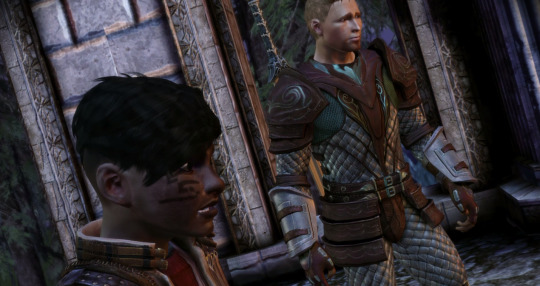


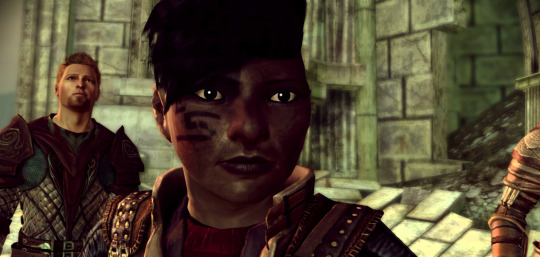




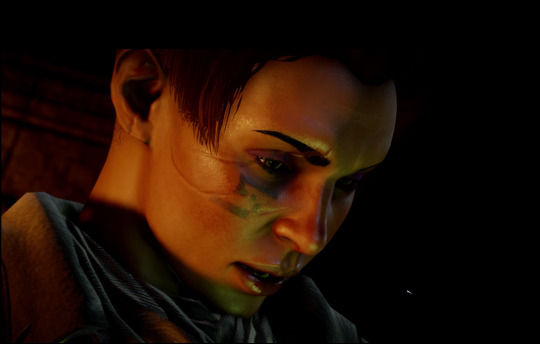



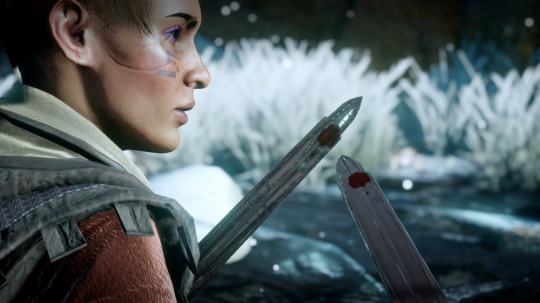



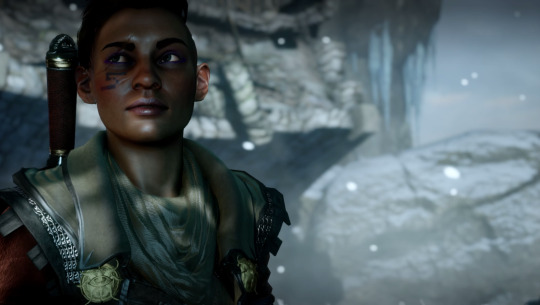





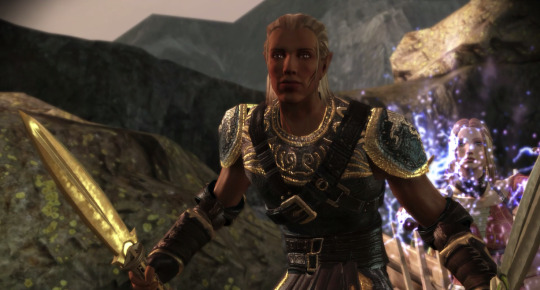




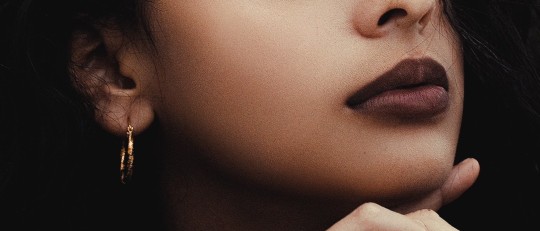
More about Eilin under the cut if anyone's interested! :)
Eilin's Origins Tapestry Here!
Pic sources are from Pexels ~ [ 1 ] | [ 2 ] | [ 3 ] | [ 4 ] | [ 5 ]~ The two quote pics are from Pinterest. The others were all taken/edited by me from the Dragon Age games themselves.
Name Pronunciation:
Eilin is pronounced as AYLehn
AY is pronounced as ie in tie
L is pronounced as l in let
eh is pronounced as e in pet
n is pronounced as n in no
Gender:
Genderfluid/Non-Binary ~ AFAB (assigned female at birth, female anatomy) ~ they/them pronouns (will also accept he/she pronouns since they’re fluid).
Orientation:
Pansexual.
Age:
24/25 (Origins, 9:30 Dragon) ~ 35/36 (Inquisition, 9:41 Dragon)
Class:
Rogue ~ Longsword/dagger combo (preferred) or dual daggers
Specializations:
Ranger ~ Duelist ~ Legionnaire Scout
Name of Their Mabari:
Samwise. The hound was cheekily named after one of their favorite characters in one of their favorite pieces of human literature. They remain steadfast companions to this day.
Romance:
Zevran ~ He tried to kill them…TRIED being the operative word. Even so, Eilin was impressed by how close he came to accomplishing his mission, and quickly grew attached to the Antivan Crow right from their first mouthy meeting. They saw much of themselves in the man and found a kinship with him early on. Their romance is a slow burn as they both must try to heal past scars and allow themselves to fully open up to their growing feelings for one another. After the Fifth Blight is ended, they stay together and travel Thedas in search of a cure for The Calling whilst enjoying the pleasures of each other and the world with their earned freedoms, helping others when and where they can…maybe with a bit of profit as well ;)
Besties:
- Alistair ~ Their first companion and Grey Warden ally who became like a little brother to them. Even though Eilin is more mature and straightforward than him, they share similar senses of humor, and Eilin sees the good (and deflections) in him after so much discontent with the hand the world has dealt him, a sentiment they deeply share amongst others. Despite Eilin’s doting on him, they do not coddle him, but instead try to talk him up and show him what a great warrior and person he is and could be, giving Alistair confidence to stand up for himself and push him to possibly become Ferelden’s king—though that path is decided against for several reasons. Alistair and Eilin share a true and lasting friendship to the present day.
- Shale ~ Witty, dry-humored, gemstone-loving bestie! They share a deeper disconnect to their home away from home and instead find connection in each other…through shiny things and crushing Darkspawn heads. Eilin finds Shale (and golems in general) interesting, though their curiosity is stemmed after The Anvil of the Void scenario. Eilin supports Shale’s free will and ability to find purpose in their new life outside the parameters of expectations, as they have done. The one thing they disagree on is the destruction of the pigeon population, Eilin believing that even the most vexing of feathered defecating devils need love, too.
- Oghren ~ A respected warrior of merit and a fun drinking buddy, within reason of course. Eilin tries to keep him on track with his alcoholism and with Felsi and being a good, if absent, father. They are glad to continue their friendship into the Awakening escapades.
- Anders ~ These two share excessive, fun personalities that color the Awakening experience for everyone…or cause a massive amount of scoffs and eyerolls. Anders became another (albeit, more powerful and self-aware) little brother figure for them to watch over and support. Frankly, Anders became the one who watched over Eilin and educated them on the harsher side of things regarding The Circle, a welcomed perspective for the Hero of Ferelden that strengthened their positivity towards mages and distrust & dislike of the Chantry and its oppressive systems. They both dote on Ser Pounce-a-Lot, and when Anders is forced to give him up, he contacts Eilin to keep him at Weisshaupt as the mouser for the fortress’s larders. Aside from that, Eilin takes care of the precious little furball because they love animals and cares about Anders, even after what befell Kirkwall’s chantry.
- Sigrun ~ A respected Legionnaire scout with a heart of gold that bonded with them over their time in Awakening. As someone who’s always held The Legion in high regard, Eilin appreciates Sigrun’s goals and learns some of Sigrun’s tricks of the trade in Awakening.
Frenemies:
- Morrigan ~ While gaining a better understanding of her and mages through their journey, The Dark Ritual’s revelation had their trust for the woman plummeting. Still, Eilin could see and understand Morrigan’s proposition held more than what she was outright revealing, especially with the two’s overall friendship they’d formed and Morrigan’s feelings about Flemeth and her ways. Eilin decided to kill the old woman to gain Morrigan’s favor and rid the world of a powerful maleficar…for now. It was having the former topic’s discussion with Alistair that really threw things into a spiral, but they were all in agreement in the end. Alistair and Eilin’s bonds of friendship carried them through the decision to take Morrigan’s offer. Eilin pursued Morrigan later on to try and check on her and gain some kind of answers, but the woman continued to successfully elude them.
- Wynne ~ While Eilin respects the woman and appreciates her skill and experience, they find her air of superiority hard to tolerate and often feel that Wynne speaks down to them and lectures far too often on things that aren’t her business…specifically on their relationship status with Zevran.
- Velanna ~ The Dalish mage was too hotheaded and closeminded for them to fully get along, but Eilin tried to understand where she was coming from nonetheless, sharing a mutual feeling of wanting to protect/save their sibling(s) no matter the cost.
Enemies:
- Loghain & Rendon Howe ~ For the man who helped free Ferelden from Orlesian rule and was held in such high regard, Eilin expected more from him, especially with what went down at Ostagar. And for Loghain to allow a cave tick like Howe to run around behind the scenes and make things all the worse threw their opinion of them both over the edge into revenge territory, almost feeling as strongly as Alistair on the whole matter. In the end, Eilin ended Howe’s life, and they allowed Alistair to challenge and deliver the final blow to the man who they believe deserved a punishment befitting of him. What could be more fitting than decapitation at the hands of his best friend’s bastard son? Poetic justice, they’d call it.
- Isolde & Eamon ~ Teagan rides a fine line being listed here as well, being Eamon’s brother and sharing his sibling’s sentiments, but Isolde is on a whole other level of insufferable to Eilin. Not only was she irresponsible with her own son and refused to acknowledge his budding mage powers that put the entire village of Redcliffe under siege to the undead, but her purposeful mistreatment of Alistair—all rooted around a rumor—and Eamon’s conscious negligence of him and the situation also solidified their hatred of these two. They never said so aloud to Alistair who seemed conditioned/content to be grateful to his abusers in one way or another, but Eilin was good at being subtle.
- Sten ~ Eilin tried to understand and be patient with the Qunari and the concepts of the Qun, but felt Sten’s creed to be too akin to that of the unforgiving casteless system in Orzammar. Later, they butt heads over the whole “you look like a woman” conversation, which left Eilin in a foul, murderous mood. Then, Sten’s constant scrutiny toward them and their ability to lead finally resulted in a confrontation in the village of Haven leaving the qunari at the business end of their blades. Sten surrendered, but Eilin “kindly” asked Sten to leave the team for good. They’d had enough.
- Leske ~ Sadly, this was one person Eilin was not expecting to be their enemy. Ever. Perhaps they were in love with him and always had been. Perhaps they were to remain only friends with (past) benefits who could tell each other anything. Perhaps they were only Carta thugs united under the stresses of everyday life in Dust Town, watching each other’s backs on principle alone. Perhaps Leske only really wanted to get close to Rica, as more than his jokes would imply. Perhaps Leske truly, finally gave in to the Carta’s whims, being sucked back into its seedy underbelly all because of monetary gain. Or, perhaps, it was all of the above…along with a helping of jealousy on Leske’s end. Whatever the case, this loss for Eilin changed them significantly, and is an ever-present bruise on their heart. They have moved on, but if pressed upon, it aches.
Do They Follow A Religion?
The Stone ~ Though most dwarves do not believe casteless to be favored or even acknowledged by The Stone, Eilin still believes and keeps their faith in mind, not outwardly expressing it unless it’s brought up. It was something they held onto those long and lonely days in Orzammar under the Carta’s thumb, for themselves and their family.
Strengths:
- Adaptable.
- Confident, even if they “fake it ‘til they make it.”
- Able to think on their feet and keep their cool when necessary. Subtlety can be the key to victory.
- Great leadership and enforcer skills, uses a mix of persuasive and intimidating tactics.
- Though logical and pragmatic at their core, they can and will tap into their emotional reserves to be a better leader/friend (this is a progressive trait gained through their DA:Origins journey).
Weaknesses:
- Their sharp & droll tongue can get them into trouble/offend others.
- Masking to fit in, leading to varying sorts of discontent.
- Sometimes they're a bit too lethargic, but a personal side effect of The Joining for them is heavy fatigue.
- Blunt without tact, their Carta life rearing its ugly head at times. This also can result in a lack of giving second chances with some people.
- Flirty and wanton, but truly emotionally distant, craving a real chance at romance and love, but fearing it at the same time, not wanting to be hurt or left behind. This is especially true after dealing with Leske and the Carta in Orzammar.
Personal Issues:
- Letting go of the past and betrayal(s).
- Allowing themselves to make mistakes without fear of cruel/unusual punishment (mainly to their family who are now safe with a net of nobility with Bhelen).
- Aligning themselves with true love and relationships, romantic or otherwise.
- Changing and growing out of their Carta (and other) personas to find themselves and their true values.
Hobbies/Talents:
- Stone/gem carving
- Weapon care, and blade engraving for extra flair.
- Reading human literature/fiction.
- Collecting a variety of bits and baubles.
- Drinking anyone up to the challenge under the table with their high alcohol tolerance.
Likes:
- Colors: Purples, slivers/ice blues, golds, oranges, and greens – cooler/cold and nature-esque shades.
- Layers of clothing. It lets them feel safer and more guarded. Plus, they like cooler weather, so it stands to reason they’d need more layers.
- The changing seasons. Winter and spring and the petrichor smell that comes with the snow and rains, autumn and the colors, and the familiar dryness and heat of summer keep them from feeling too homesick.
- The surface world in general and the freedom and opportunities that come with it. The adventure of it all keeps them going, as does the elf they share their journeys with. 💖
- Animals! They become a ranger class for a reason, not only seeing animals as opportunistic companions for battles, but also because Eilin gains an affinity for them. Still, they’ll always love giant spiders the most and summons one (christened “Nid”) to ride as their preferred steed.
- Gemstones, trinkets, and human literature. More often than not, the books, bits, and baubles they collected were spoils of Carta shakedowns gone south, some regrettably so. Some were trophies of success, others a kind of “memento mori.” They kept them all, nonetheless. (Think of them as a somewhat morbid Ariel from Disney’s The Little Mermaid lol).
- Passionate artisans of their crafts/pursuits, whatever that may be as long as it isn’t hurting/impeding others. This stems from their observations of the better side of the pride of the caste system. Even casteless, Eilin can see and appreciate the efforts their fellow kin put into their lifelong works. This is a big reason why she helps Dagna out of Orzammar to pursue her dream of working with The Circle of Magi. Zevran being passionate about being an assassin is also a good example, as is Wade’s need of perfection with his armor making in Denerim.
Dislikes:
- Animal abuse of any kind.
- Petty political/noble affairs.
- Willful ignorance.
- Lack of flexibility in and around rigid systems.
- People unwilling to have a little fun/laugh at themselves
Scars/Blemishes:
- Their brand tattoo on the right cheek (the design extends upward over the right eye, but cannot be seen in original Origins screenshots and was not available in Inquisition’s tattoo selections, sadly. I’ll have to draw them sometime to show off my personal vision of them lol).
- Scars on right side of face, ear, and neck (Inquisition screens) that they received from skirmishes with the werewolves from the “Nature of the Beast” quest and other various fights.
- Various moles/beauty marks.
- Dryer skin patches from exposure to Dust Town and Orzammar’s environment in general.
Their Origins/Awakening Journey:
- The Broken Circle: Sided with the mages and Irving survived the final fight with Uldred.
- The Arl of Redcliffe: Redcliffe was fully saved and Connor & Isolde lived with the help of the mages.
- A Paragon of Her Kind: Sided with Caridin, destroyed the Anvil of the Void, and Bhelen rules Orzammar.
- Nature of the Beast: Brokered peace between the elves and the werewolves.
- The Urn of Sacred Ashes: The Urn was protected.
- The Landsmeet: Loghain was defeated and executed by Alistair, Anora rules Ferelden.
- Was The Dark Ritual Performed?: Yes, (sadly for Eilin) by Alistair. It took a long talk and trust for these two friends to allow Morrigan's ritual to take place. 😞
- Warden’s Keep DLC: Sophie was killed and Avernus is alive with permission to continue his research, but it must be kept ethical. Eilin drank the strange concoction and unlocked the power of blood.
- Dragon Age Awakening: Vigil’s Keep and Amaranthine were saved, Nathaniel is alive and well, Oghren and Felsi reconciled, but are separated, and The Architect is dead.
#oc: eilin brosca#dragon age#dragon age origins#dragon age inquisition#dragon age brosca#dragon age oc#dragon age warden#hero of ferelden#warden x zevran#brosca x zevran#zevran romance#zevran arainai#dao#dai#oc#original character#character design#character moodboard#i am finally sitting down to play through a zevran romance of my own dammit! he deserves it! and so does eilin! I love them T^T#i'm also using eilin as a way to cope with some gender dysphoria i'm experiencing atm...*sigh* just feeling like a blob of a person rn#i need to draw eilin at some point b/c the constraints of character creation even with mods is just so frustrating gahhhhh#and my god the darker skin options in CC for origins makes them look like they're covered in dirt instead of it being natural skin >:T#*sigh* inquisition's isn't all that much better b/c of the CC lighting they provide. uuuugh. i tried.#i should really just draw them#enby character#nonbinary character#genderfluid character#genderfluid#gender nonconforming#genderqueer
5 notes
·
View notes
Text
Portrait for my Hero of Ferelden - Sylvaine Mahariel. 🖤

#character design#dragon age#dao fanart#dao#drawing#hero of ferelden#grey warden#mahariel#dalish#dragon age origins#my art#kae art
26 notes
·
View notes
Text
I honestly do not mind the d/ragon age names like a/mell or l-vellan bc already the warden and inquisitor title suck plenty when referring to a hero.
#i do not mind my guy having a name over being called a cop or a catholic witch hunter#i can't believe s/wtor got it better and designated the title of inquisitor to the guy from the *villain* faction#and i know warden doesn't have legal connotations assured but... but...#and i do love the warden (as in the hero of ferelden)............. but!#also h/awke being called champion.... the wow protagonist is called champion lmfao
7 notes
·
View notes
Text
the funniest part about all this research i've done is it's gonna result in a plain design because surana is someone who lived most of her life wearing easily mass produced clothing in the circle and then the last year of her life near permanently on the move so there's not going to be anything elaborate. she's going to wear a kirtle.
#ama mumbles#amas dive into ferelden fashion help me#surana (oc)#im not designing an outfit for katla. i refuse to. ive suffered enough#and the ultimate kicker. I Still Don't Know What To Make Surana's Armor Look Like#that started all of this! and then i feel down an undergarment rabbit hole bc thats where you build an outfit from#head in hands
6 notes
·
View notes
Text
Andrastian Design: Tapestry and Tryptich

Even though there is tapestry of each cultural group all over DAI, it’s common to associate tapestry with Ferelden mainly. In game we mostly find in Ferelden houses some of these Tapestries, that like the Stained Glasses of the Chantry, narrate the story of Andraste.
The main reason why I assume these are Ferelden-made is basically because, 1) we find them always inside houses and castles of Ferelden, and 2) by analysing their frame, they are associated with the Ferelden Wyvern.
The frame
Fist of all, let’s see the details of the frame: They are decorated with a beautiful colourful complex set of patterns: dots, geometrical lines, circles, swirls, half-circles, and star-like figures compound it.
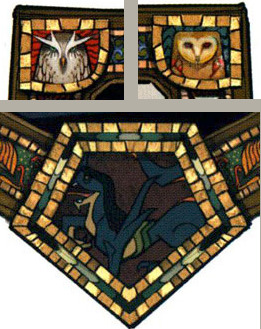
On the top corners we find two different kind of owls.
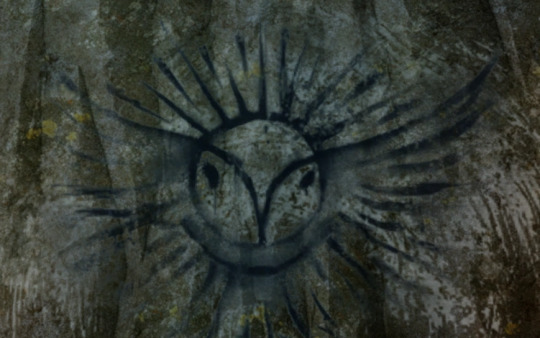
Owls have always been part of Ferelden design because they belong to their alamari heritage, given the important role that the Lady of the Skies [represented as an owl too] have in the alamarri/avvar religion. Since they are also quite close to spirits, I would not be surprised if these owls are also a link to the Elvhenan [we know that a curious pair of birds can be found in the Hidden Armoury [Elven mountain ruins] and there are many owls in Skyhold [specially in the front gates and in the basement library that may or may not be related to the ancient elvhen presence in it] as well as in the Inverted Ward.
In the lower part of the frame, we find a Ferelden Wyvern, which are represented in several places throughout DAI. They are related to a non-official folktale of Andraste that we find in one of the books of World of Thedas. The tale is quite meaningless and shallow [more details in Crestwood]. This detail is the main reason why I think these tapestry are strongly Ferelden made.
The Story of Andraste
1-Unknown Event
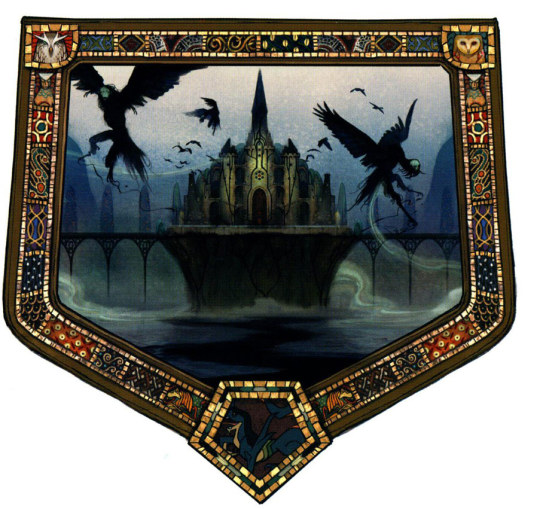
The first of all these tapestries is the one most difficult for me to understand. Based on the Chant of Light, it may represent the dark times alamarri were living; most of their territories were invaded by Tevinter, their resources were stolen and their people were kidnapped and turned into slaves. These strange harpy creatures may be a rare representation of Tevinter preying on Alamarri [it’s very strange since Tevinter is always represented with a snake or a dragon]
On the other hand, we see two bridges and a big elevated structure that makes me remember Ostagar, which was a Tevinter structure to keep the Chasind away from the invaded regions of Ferelden.
Another interpretation is that this may represent the Golden City of the Maker, desecrated with the entrance of the Magisters. We have to remember that Andraste’s Tale comes half a century after the end of the First Blight. Still, it’s a weird representation since it’s not a floating city in the air, but a fortress in an island, with access through bridges, and there is water bellow.
We also know that by that time, Andraste called the Alamarri gods for help, but they remained silent [meaning, neither the Lady of the Sky, nor Korth, nor Hakkon answered her] and this scene may represent the despair that such situation may have caused.
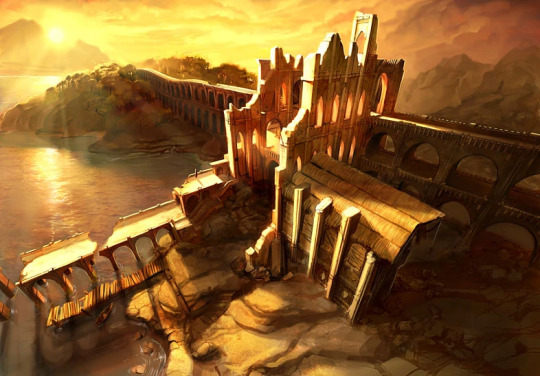
Finally, as a last interpretation, this structure may be Kinloch Hold, where the current circle of Magi of Ferelden is located. The original construction was built by the Avvar with some help from dwarves. It served as a fortress and a watchtower and was long considered impregnable until the Tevinter Imperium drove the Avvar from it in a brutal campaign. Maybe this image represents Kinloch Hold but surrounded by harpies and despair due to the lack of answer of the gods while the avvar were attacked by the Tevinter forces.
In any case, I can’t totally trust 100% any of these interpretation. The drawing is very strange for the lore we were given.
2- The Maker speaks to Andraste

Without the answer of her gods, Andraste roamed the forest of Ferelden until the Maker appeared. Here we can see once more the figure of a man, without face, covered from toe to head, only wearing a crown. He is presented with a glow of green and golden, making his connection to the Fade a bit subtler in this drawing than in the Stained Glasses.

His veil has a pattern of what I think it’s a rose or a flower with vines, but sadly it’s not easy to see the details. I could not find a better quality image for a decent zoom-in.

Over him, we see the moon with three borders, and I can’t avoid making a connection with the murals of Solas [Murals in DAI] where the Veil is represented with thick borders. This is very curious because in the other tapestries the moon appears like a normal element in the drawing, so this representation emphasises to the Player [not to the people inside Thedas] that there may be some special relationship with the moon. It’s also worth noting that the moon has a yellow/golden border same as the figure of the Maker, and golden decorations are usually related to godhood [at least inside the elvhenan context].
This scene represents the verses of Andraste 1 [Chant of Light - Part 1] where the Maker claims that the world has forgotten him, and invites Andraste to join him to the Golden City and leave the sorrow behind, but Andraste asks him to forgive humanity. He accepts, promising his return if his children listen to her.
3- With Maferath, Andraste leads the Exalted March against Tevinter
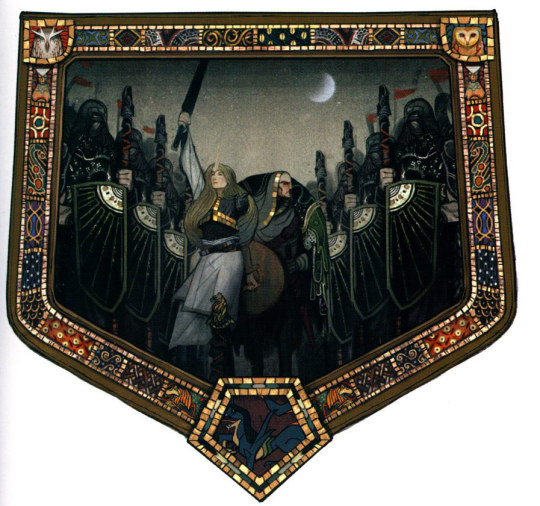
Here, Andraste and Maferath lead an Exalted March against Tevinter in order to spread the word of the Maker and stop Tevinter oppression all over the alamarri lands. We see in this tapestry several alamarri warriors using a shield with the symbol of the Sun and hilts with wolf/mabari shapes. Again, the mabari is a Ferelden icon, while the Avvar prefer the wolf, since it’s an animal of freedom and not tamed as the hound [A Plea from the Warrior to the Spirits]. Depending on how we perceive the alamari around Andraste, this hilt can be also a subtle elvhen symbol of rebellion. I insist in relating the Avvar/alamari with the elvhen simply because their perception of the world of the spirits gave them similar wisdom than the Elvhenan.
Andraste is also wearing her typical one-spiked crown. Behind her we can see Maferath. She and Maferath wear a common element: a series of golden tiles around their chest or veil to emphasise the link they have: they are the leaders guided by divine words in this “divine” march against Tevinter.
Also, notice how different the moon is represented in this tapestry in comparison with the previous one.
4- Andraste fights in Tevinter territory

This seems to be a depiction of a battle close to Minrathous. The background shows typical Tevinter buildings. On the left side of the tapestry we can see Tevinter warriors being killed by arrows [probably a subtle calling of Shartan presence], while Andraste, as a [superheroe] warrior, jumps in the air.
Behind her, we see a lightning and a dark cloud, suggesting three potential things: when we read about the role of Shartan and the elves, their contribution is usually described as the responsible for creating “dark clouds of arrows that fall upon the enemy”.

The other interpretation, more andrastian, is that the Maker presence is there, helping them in battle. Finally, in the last interpretation, this cloud may be a representation of Andraste’s magical powers [in DAO we have the icon of Tempest looking similar to this: clouds and lightnings]. There is a glowing circle behind her face similar to the moon in the previous tapestry. These details may reinforce the idea of Andraste as a prophet of the Maker, or as a mage [specially if we read about her childhood with that strange episode of her half-sister dying in a fire, in the middle of the forest, implying that Andraste may have lost control of potential magical powers or was possessed by some spirit; the interpretations of this vague episode can go wild].
On the right side of the tapestry, I can see a statue that I suspect is of Nevarran origin [Egyptian-like design], meaning this battle may have been close to the borders of Tevinter and Nevarra.
Again, like in the post of Stained Glasses, I don’t find a particular group of verses where Andraste narrates her movement across Ferelden, the Waking Sea, and Nevarra to attack Tevinter lands. The closest verse to this action is in Shartan Verses [Chant of Light - Part 2] but also historical battles are implied in Hymns and Transfigurations [Chant of Light - Part 1] where Andraste prays to the Maker before heading to combat. It is curious that there is no verses about the “travelling” part of Andraste and her armies, not even when crossing the Waking Sea and Nevarra in which land there are some tales going on as we saw in Emprise du Lion: Pools of the Sun with her supposed Nevarran disciple/lover Hector. In fact, in this local tale, the event of the betrayal is placed there, in Nevarra and not in front of Miranthous ready to lay a siege [hence my complete confusion about where exactly this betrayal happened, and if any siege to Miranthous truly happened].
5- Andraste is handed over to Tevinter

In this scene we see when Maferath hands over Andraste to Tevinter. Since in the previous tapestry we see hints of Nevarra, and then we have this tapestry of the betrayal, we can assume that the tapestries narrate Andraste’s story in a way that makes Hector easy to be included [check Emprise du Lion: Pools of the Sun], while the Stained Glasses seem to remove any presence of Nevarra in her story. But the Stained Glasses have the presence of Shartan, which has been completely erased in these tapestries, making me suspect that maybe these tapestries keep the tale of Andraste with a strong Ferelden vision, probably closer to the most ancient versions of her tales [likely before the Long Walk of the free elves to the Dales, time when the tale of Shartan appears as we saw in The Chantry and the Mythology of the Chant of Light].
Here, we see Andraste being held by two Tevinter guys who look very evil. Like in the Stained Glasses, Havard is not here either. According to the Chant of Light, The Aegis Havard was supposed to be here, and unable to fight his Lord Maferath as well as to hand Andraste over to Tevinter, he puts himself in between Andraste and the evil Tevinter and ends up deadly wounded [Chant of Light - Part 2].
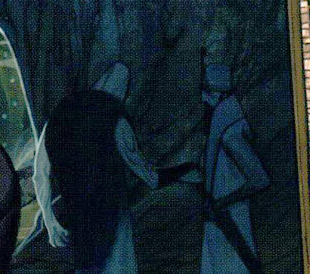
In the shadows, representing the secret arrangement, we see Maferath giving a handshake to Archon Hessarian.

Behind them, a snake passes by: it has the tip of the tail golden, continues black, and then it turns out white. I’m not so sure if this means the transition of Archon Hessarian, from worshipping Old Gods, to kill Andraste, and then repent and became an Andrastian follower himself.
In the background, we see more Tevinter buildings with “evil” red glowing windows.

The moon has a similar style to the one we saw in the tapestry with the Maker, but its borders are smudged. The colours seem to be the same ones but desaturated and muddy.
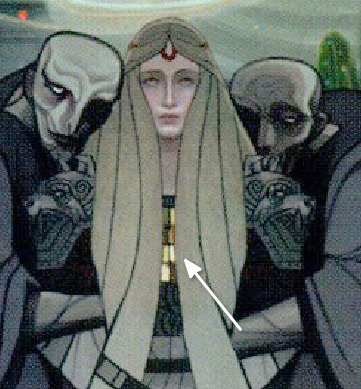
I’m not sure if this represents some “lack of presence of divinity” since Andraste’s golden tiles are also hidden below her hair, giving the idea that the Maker abandoned her. She is not wearing her typical one-spiked crown either.
This tapestry represents the verse of Apotheosis 1 [Chant of Light - Part 2].
6- Andraste is killed

In the next tapestry we see the public execution of Andraste in a pyre. The background shows Tevinter buildings, suggesting this is Minrathous.

On the left we see Havard, the avvar warrior who is wearing a klimt-yellow robe. He is looking down, lamenting this situation. He is not “deadly wounded” as the Chant says. It seems that in this Ferelden version, Havard never was in the moment Maferath hands over Andraste, so he appears safe and sound at the moment of her execution.
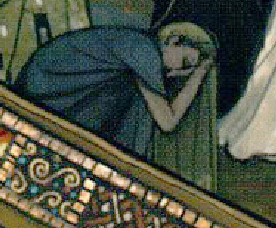
Close to Havard, we see a woman, kneeling as she cries, that maybe is Justinia, the original one. I guess this because it makes not much sense to add a random woman in this scene; all the characters present in this image have a relevance in the story of Andraste.
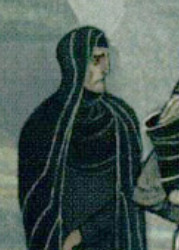
There is also a Tevinter man in black robes who also seems sad about this execution [Is this Trefir? the Archon’s slave who left Tevinter carrying the Sword of Mercy and was supposed to found the Blades of Hessarian?, more details in “The Chantry and the Mythology of the Chant of Light”]. I’m surprised of seeing another “sad Tevinter” considering this is made by Ferelden and one would expect a more anti-tevinter propaganda.
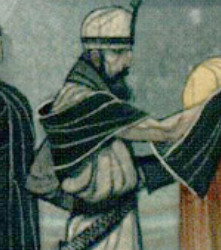
In the centre we see Archon Hessarian, wearing a white robe, the same white that Andraste. This is very unusual given the typical dark outfit of the high hierarchy in Tevinter, so I’m inclined to interpret his figure here as “a purification” that the Archon experienced when he killed Andraste out of Mercy. If Andraste was purified by fire, the Archon was so by his merciful act. Again, a veeery rare representation of Tevinters, specially coming from a Ferelden source. As the Chant claims, he is sinking his sword in Andraste’s heart to give her a merciful death.

In the pyre, Andraste’s bleeds to death, tingeing her hair of red too. she still wears a minimal line of golden tiles.

On the right side of the tapestry, we see Maferath, leaving the scene with some facial gesture of regret, while holding in his hand a crown, that may represent the Maker, as if “he removed the Maker influence in this story”, or more likely, to “recover” his leadership of the alamarri.

I think this crown has one longer spike, so it may be Andraste’s crown, but it’s not the same crown that Andraste uses in previous tapestries, so the interpretation is a bit more loosely. Ferelden art depicts Andrates’ crown in very different ways.
The verse that this tapestry represents is Apotheosis 2 [Chant of Light - Part 2].
7- Andraste ascends

Here we see the ascension of Andraste to the Maker’s side. Also, notice that this tapestry shows a normal moon too.
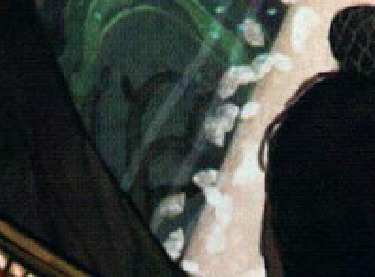
The background displays two tree, one of them looking a bit like a thorny vine. There is a sky full of stars. An intense white light wraps her and makes her raise. She is wearing white, implying how the fire purified her. Below her, we see Maferath and Archon Hessarian, surprised.
The verse represented in this image is the last part of Apotheosis 2 [Chant of Light - Part 2].
8-Havard takes Andraste’s ashes

In the last tapestry, we see Havard, wearing this iconic klimt-yellow robe, carrying Andraste’s ashes in the night, leaving Miranthous/Tevinter. We will know later that he went to the Frostback Mountains to build Haven, founding the Temple of Andraste that later will be developed into the Disciples of Andraste.
The verse represented in this image is the last part of Apotheosis 2, [Chant of Light - Part 2], even though it is curious that the Chant claims that Havard was healed by the ashes of Andraste, while we see in the tapestries that he was not even hurt. It’s also curious he looks more like a mage [yellow robe and staff] than an avvar warrior.
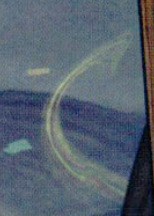
Many of these tapestries, including this one, display small lines of green in the scenery as if it were mist, but they give an eerie feeling to the drawing, almost a subtle Fade-y effect.
The Orlesian Triptych
Why do we assume this is Orlesian? Simple: it’s not only over elaborated, it has a Quincunx design in it [more details below] which is present in the Orlesian design of rugs,
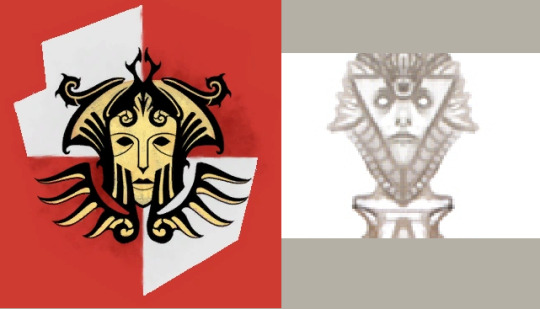
and has the typical triangular face of Orlais, that may represent Andraste [we find it in many sculptures of Orlais], Celene or Drakon’s Heraldry. I cannot point out exactly who is this triangular face, but all these options look reasonable in my opinion.

The Orlesian triptych is focused on the execution of Andraste and her later ascension.

At the top we see three iconic symbols in circles: in the centre, below the Orlesian face [or Drakon’s heraldry, I never know], we find a circle depicting the Golden City. At the right side, the typical icon of the six snakes with that little polygon in the middle, which used to be the typical symbol to represent Tevinter in a more “arcane” way [ check Nation Art: Tevinter].

On the left side, we find a simplification of a Ferelden symbol we found in Nation Art: Ferelden, which shows a face crying. I assume this is a representation of Andaste’s face in a Ferelden style or a vestige of a Sun-based religion before the alamarri trinity religion.

As apparently Orlesian design implies, the triptych shows the 3/4 of a Quincunx, completing the fourth circle on Andraste’s heart. Therefore, the middle of the complete Quincunx would show the face of Andraste wearing her typical spiked crown. The Quincunx has been quite a repetitive element in DAO, being forgotten in later games. In DAI we only see it in Solas’ Tarot Card, and in some Orlesian designs that are seen in the concept art but not inside the game so far I’ve seen.

Below the Ferelden symbol, we see Maferath. He is wearing a crown of three spikes, a bit squared. He can’t see the light that Andraste radiates. Ironically, he is drawn in a more darker and evil way than the Archon, which is surprising for me, since Orlais did not show a strong negative sentiment towards Maferath as Ferelden does [in the Hinterlands, we see in very raw sculptures the strong rejection that Ferelden has towards him in general]. Instead, I was expecting Orlais, headquarters of the Chantry religion, to be more negative towards Tevinter because their Imperial Church.

Below the symbol of Tevinter, Archon Hessarian looks at Andraste, unbothered by the radiance, ready to use the sword as we can see his hand ready, close to the hilt of the sword at his waist. A white snake is surrounding him, probably as a symbol of his change of heart that gave him some level of “cleansing”.

The two panels are separated by a sword that lays over the burning body of Andraste: this is the Sword of Mercy that we see in many other pieces of art. Curiously, it’s the same sword that the Tevinter Warrior holds in the statues Female Kossith/ Desire demon /Tevinter Warrior which decorate the columns of the Imperial Highway. This makes me suspect, in combination with such a positive view over Tevinter elements, that maybe this triptych is older than i expected, maybe older than the Schism of the Chantry. However, we have no information to confirm or debunk it, sadly.

When we open the Triptych, we can see Andraste, purified [wearing white] and the sun behind her.
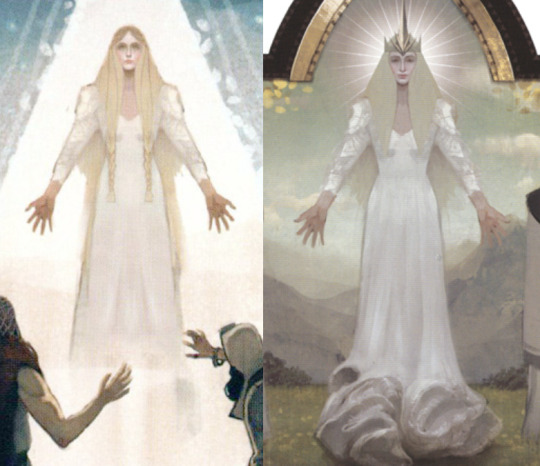
This figure is a copy of the tapestry of the ascension of Andraste: I mean, from a design point of view, the designer copy-pasted the same Andraste and altered it a bit, meaning that one of these pieces of art if the copy of the other.
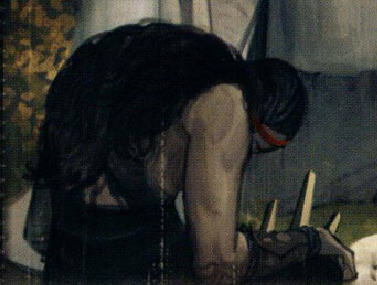
On the left, we see the Ferelden side: Maferath is kneeling down, defeated, regretful, with his crown on his lap.

The Chantry hierarchy can be easily seen here represented by the three people lamenting Andraste’s death and looking down at Masferath: Sister/Brother and revered Mother.

Beside Andraste, we see the “white” Divine, the Divine with main residence in Orlais.

On the right, we have the Tevinter side, mirroring the left side: we see that Archon Hessarian is on the ground, regretful, in similar position to Maferath. He, as well as Maferath, wears a red cord in his head that was not present in Maferath’s head in the previous image. I don’t know what it could mean, since it stands out a lot in the drawing of dark and white colours.

Behind him, we see a group of Tevinters that I assume belong to the hierarchy of the Imperial Chantry. Just by the outfit, we can see a magister, and probably a Revered Father and a sister.

I assume this one marked in the image is the magister simply because he wears similar to the Magister Erasthenes that we meet in Orlais: Shrine of Dumat.
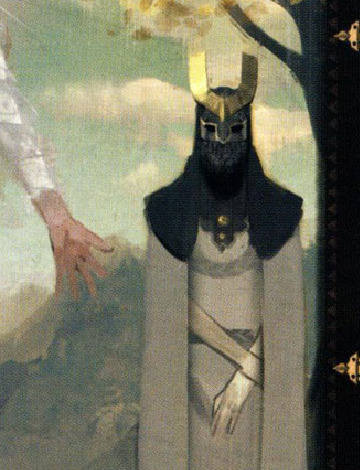
Beside Andraste, if I’m not mistaken, we can see the “Black” Divine, the imperial Divine. The curious helm he uses reminds me a lot of the mysterious symbol we found in Hinterlands: The Unknown Ruin.
Now, this Triptych is astonishing and mega-surprising for the presence of the Imperial Chantry in equality to the Orlesian Chantry, “Black” Divine included, since he’s considered a “false” divine. So, I think that this triptych, usually seen in Orlesian places, is quite subversive. I’m sad we don’t have much information about who painted it and when, because, again, to place the Imperial church in the same level than the orlesian Chantry, mirroring it no less, it’s very, very strange.
#andraste#andrastian design#maferath#hessarian#archon hessarian#chantry#chant of light#sword of mercy#ferelden design#Ferelden Wyvern#owl#Quincunx#the sun symbol
24 notes
·
View notes
Text

warden and hawke being bffs
#dragon age origins#dragon age 2#hero of ferelden#hawke#my art#honestly i just picture my canon heroes as a whole friend group#they're all so cute#this is my final design for hawke#i mean this is like a modern au but this is his general look#theyre not in love theyre just both hot#i love them#oh and here we see my new signature#that my insta at if you can even read it
1 note
·
View note
Text
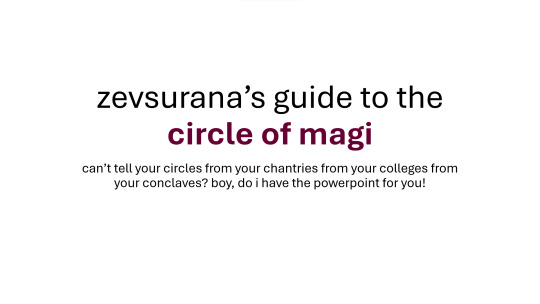
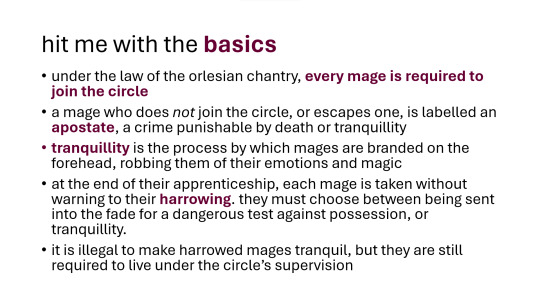
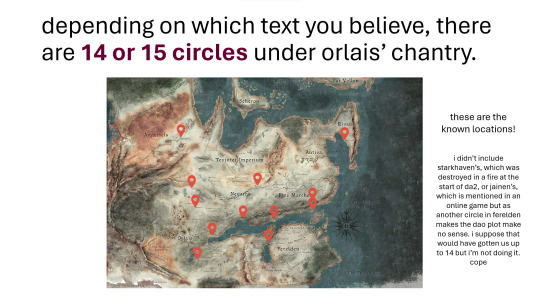




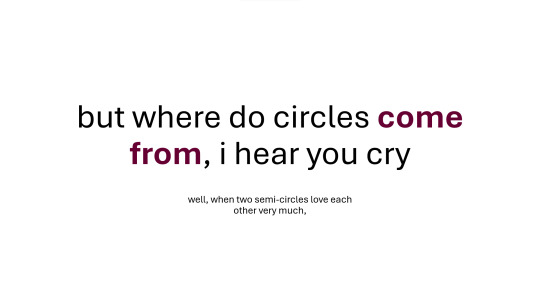
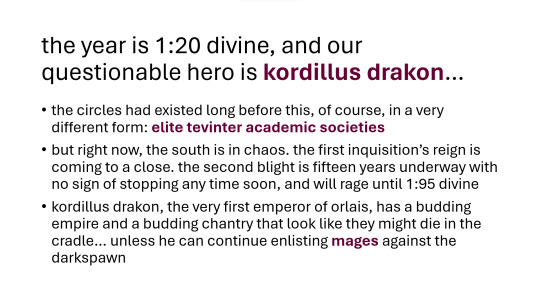

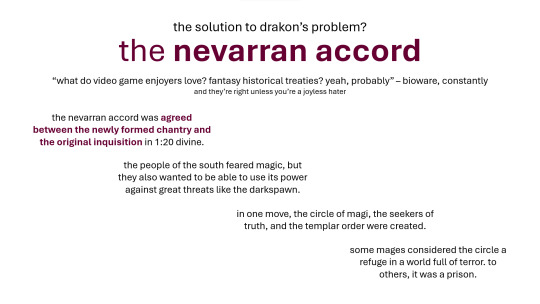
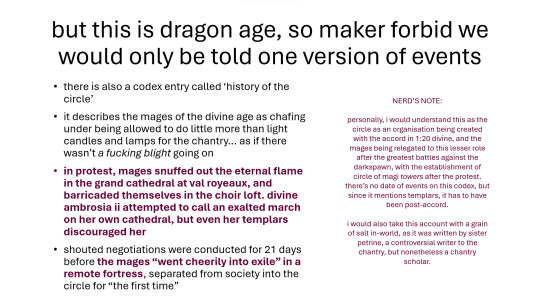


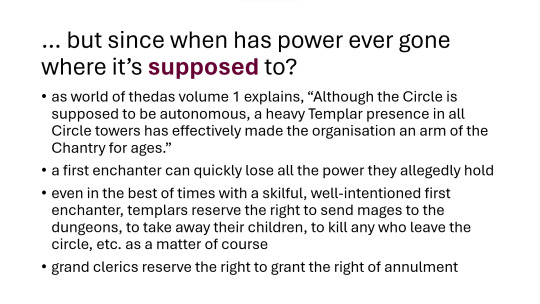

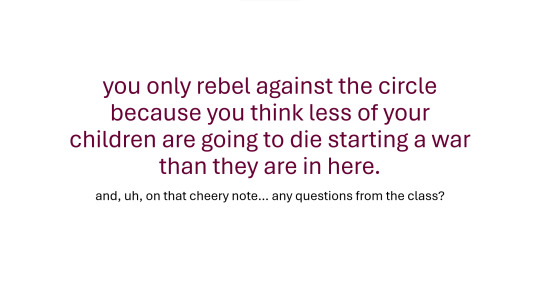
back and even bulkier with another powerpoint! i opted for spreading the information out in a hopefully engaging way over limiting the number of slides. the circle is a BIG, big topic, with such focus over the course of the games, so if i didn't cover anything useful, you want to know anything more specific, or equally if i made a mistake and missed or misinterpreted something, please let me know ily!!
transcript below the cut! my eternal thanks to @bisexualcommandershepard for providing one for the previous powerpoint and in doing so reminding me to get my act together, you have my sword
zevsurana’s guide to the circle of magi
can’t tell your circles from your chantries from your colleges from your conclaves? boy, do i have the powerpoint for you!
hit me with the basics
under the law of the orlesian chantry, every mage is required to join the circle
a mage who does not join the circle, or escapes one, is labelled an apostate, a crime punishable by death or tranquillity
tranquillity is the process by which mages are branded on the forehead, robbing them of their emotions and magic
at the end of their apprenticeship, each mage is taken without warning to their harrowing. they must choose between being sent into the fade for a dangerous test against possession, or tranquillity.
it is illegal to make harrowed mages tranquil, but they are still required to live under the circle’s supervision
depending on which text you believe, there are 14 or 15 circles under orlais’ chantry.
[this slide is accompanied by an image of a map of thedas. there are small markers spread across the map on 12 locations, mostly in orlais and the free marches, but included everywhere except tevinter and seheron.]
these are the known locations!
i didn’t include starkhaven’s, which was destroyed in a fire at the start of da2, or jainen’s, which is mentioned in an online game but as another circle in ferelden makes the dao plot make no sense. i suppose that would have gotten us up to 14 but i’m not doing it. cope
hierarchy of the circle
there are six ranks:
the grand enchanter is the mages’ direct representative to the divine. in our time, this is grand enchanter fiona, who famously stated “fuck the divine”
the first enchanter leads each circle. theoretically, their permission is needed for a mage to leave the tower, for a harrowing, and for a mage to be made tranquil. in practice, their actual power depends hugely on their political skill and their corresponding knight-commander
the senior enchanters are the most experienced mages in a circle, and advise the first enchanter, who will select one of them as their successor
those who have gained the rank of enchanter (also known as junior enchanters) are now expected to mentor apprentices
the simple rank of mage designates those who have passed their harrowing. an inhabitant of the circle fully capable of magic might say “i’m not a mage, just an apprentice”
the apprentices are children and young adults who have not yet completed their harrowing
outside of this hierarchy are the tranquil. they instead belong to the ‘formari’, who perform enchantment and sell enchanted items to produce the circle’s wealth
(it’s really important to me that you know the different ranks usually have different coloured robes to mark them out. i can’t explain that all here because it varies from circle to circle and we don’t have all the data but i think that’s so fun that i have to point it out even though it makes this slide super crowded i hate it i’m sorry)
politics of the circle: what are those first enchanters even doing?
an ideal first enchanter should govern their circle as a quasi-parental figure who can protect their mages while maintaining an uneasy balance and accord with the templars
they are also an administrator managing their circle’s finances
a weak or unskilled first enchanter can spell doom for their circle just as much as one at odds with their knight-commander
the college of magi is a council of all first enchanters
the college regularly meets in cumberland, nevarra, to discuss circle policy and elect the grand enchanter from among them
politics of the circle: what’s this about frat boys?
once a mage achieves the rank of enchanter, they may join a political fraternity
choose your fighter:
the largest fraternity, the aequitarians, are centrists
the loyalists are chantry bootlickers
the libertarians seek greater power and independence for the circle. the resolutionists are an even more radical group that emerged from them
the isolationists wish mages to withdraw from society completely
the lucrosians prioritise the accumulation of wealth and influence
the aequitarians maintained an alliance with the loyalists until the final vote to rebel, when wynne’s son rhys, asked to represent the aequitarians by first enchanter irving, voted with the libertarians
that was a lot of politics.
let’s take a breather because we haven’t even gotten to history yet oh boy
[this slide is accompanied by two pieces of dragon age concept art of white-haired mage women casting spells. one is an older human white woman who may be wynne, dressed in ornate robes and casting purple magic with a casually imperious gesture. the other is the concept art for warden surana, an angry-looking young elven white woman with a palm full of icy magic.]
hot circle mage concept art break. of course you have white hair and [caps lock begins] one thousand points lightning damage-- [caps lock ends]
but where do circles come from, i hear you cry
well, when two semi-circles love each other very much,
the year is 1:20 divine, and our questionable hero is kordillus drakon…
the circles had existed long before this, of course, in a very different form: elite tevinter academic societies
but right now, the south is in chaos. the first inquisition’s reign is coming to a close. the second blight is fifteen years underway with no sign of stopping any time soon, and will rage until 1:95 divine
kordillus drakon, the very first emperor of orlais, has a budding empire and a budding chantry that look like they might die in the cradle… unless he can continue enlisting mages against the darkspawn
we may wish to take a moment to register that kordillus drakon apparently looked like this. Sure.
[this slide is accompanied by concept art of kordillus drakon. he is blond white man in vaguely iron age dress, with an interesting hair cut including bangs, a high half ponytail and a very large moustache. he wears a swamp-green cloak and a black fur pelt over a green and white striped tunic, with a hand-axe slung through his belt, and crossed garters over whatever combination boots and pants he's wearing, which seems to be one singular garment.]
the solution to drakon's problem?
the nevarran accord
“what do video game enjoyers love? fantasy historical treaties? yeah, probably” – bioware, constantly
and they’re right unless you’re a joyless hater
the nevarran accord was agreed between the newly formed chantry and the original inquisition in 1:20 divine
the people of the south feared magic, but they also wanted to be able to use its power against great threats like the darkspawn
in one move, the circle of magi, the seekers of truth, and the templar order were created
some mages considered the circle a refuge in a world full of terror. to others, it was a prison
but this is dragon age, so maker forbid we would only be told one version of events
there is also a codex entry called ‘history of the circle’
it describes the mages of the divine age as chafing under being allowed to do little more than light candles and lamps for the chantry… as if there wasn’t a fucking blight going on
in protest, mages snuffed out the eternal flame in the grand cathedral at val royeaux, and barricaded themselves in the choir loft. divine ambrosia ii attempted to call an exalted march on her own cathedral, but even her templars discouraged her
shouted negotiations were conducted for 21 days before the mages “went cheerily into exile” in a remote fortress, separated from society into the circle for “the first time”
nerd's note:
personally, i would understand this as the circle as an organisation being created with the accord in 1:20 divine, and the mages being relegated to this lesser role after the greatest battles against the darkspawn, with the establishment of circle of magi towers after the protest. there’s no date of events on this codex, but since it mentions templars, it has to have been post-accord.
i would also take this account with a grain of salt in-world, as it was written by sister petrine, a controversial writer to the chantry, but nonetheless a chantry scholar.
this has been a lot of chatter about mages. but there’s an elephant in the room, and it’s looking at us suspiciously…
the circle and the templar order
the circle does supposedly have nominal independence from the chantry…
Knight-Commander Greagoir: I promised you aid, but with the Circle restored, my duty is to watch the mages. They are free to help you, however.
Warden: I thought the templars were in charge of the Circle.
Knight-Commander Greagoir: The templars guard and advise, but the first enchanter has the last word in what happens in the Circle.
...
Warden: Won’t the Circle of Magi do what the Chantry says?
Alistair: Technically the Circle of Magi is independent. We don’t know that the Chantry won’t support us, of course.
Morrigan: You truly believe that?
Alistair: If we speak to the First Enchanter, he should see that his responsibility to the Grey Wardens supersedes anything the Chantry or even Teyrn Loghain might have to say about it.
… but since when has power ever gone where it’s supposed to?
as world of thedas volume 1 explains, “Although the Circle is supposed to be autonomous, a heavy Templar presence in all Circle towers has effectively made the organisation an arm of the Chantry for ages.”
a first enchanter can quickly lose all the power they allegedly hold
even in the best of times with a skilful, well-intentioned first enchanter, templars reserve the right to send mages to the dungeons, to take away their children, to kill any who leave the circle, etc. as a matter of course
grand clerics reserve the right to grant the right of annulment
generally, the system is maintained by a mutual interest in avoiding open conflict
the templars are the ones in power with the chantry’s full support. if they drive the mages to open conflict, their comfortable routine is uprooted
templars are equipped to hunt down individual mages, even blood mages and abominations
templars are not equipped to be outnumbered or face even numbers. mages are simply far more powerful in a fair fight than they are. lyrium can only do so much
...
mages, meanwhile, operate under the not entirely unfounded belief that the outside world is entirely hostile to them
at least if they remain, they can keep an uneasy balance in which most mages survive, their existence tolerated by the chantry. they can continue studying among their own kind in the only home they know
if they openly rebel, they may throw aside what limited protections and goodwill they have. mages like wynne outright state certainty that if they rebel, “genocide” will follow
furthermore, those mages with more status have more access to privilege. they’re also the ones who have best passed the chantry’s tests. thus, those in a position to lead are least inclined to rebel
you only rebel against the circle because you think less of your children are going to die starting a war than they are in here.
and, uh, on that cheery note… any questions from the class?
689 notes
·
View notes
Text

The movements of the Hero of Ferelden after the Blight are an interesting topic, to be sure; there are entire books pondering the subject, including one rather torrid romance series banned in at least three territories. Lady Amell herself has never offered clarification, other than to mention that she's never very much been an enthusiast for ropes as the romance suggests.
What is known is that, at Queen Anora's insistence, she became the Warden-Commander of Amaranthine for a spell - a time marked by several acute disagreements with both King Alistair and her second-in-command, Nathaniel Howe (though the latter, it's said, sourced greatly from passion rather than the fervent dislike shared by King and Hero). In the end, she bequeathed leadership to Howe and made herself scarce from Ferelden, not stepping upon its shores again for many years.
The tales warp and part into separate threads, after that; some say she was seen in the company of the former usurper, Loghain Mac Tir, in Montsimmard; still others speak of her roaming the Free Marches with the Qunari who would one day become Arishok - though not since he left for Par Vollen; yet more whisper of her travels with the Witch of the Wilds, before Empress Celene made a court advisor of the latter.
Perhaps there's some truth to them all; Lady Amell has never elaborated.
What can be confirmed is that she made landfall in Antiva City some time around 9:34 or 9:35, where she encountered a Circle very much like the one she'd inhabited prior to its near total destruction. With the power and clout she'd gained for herself in her travels - along with the backing of one Tejasvin Demetrius, a merchant prince rumored to be her father, and Zevran Arainai, the only assassin known to have left the Crows and lived - she made major headway in preventing the likes of Uldred from ever happening to the Asha Alcazar.
Eventually, she became the youngest First Enchanter in Southern Thedas; when the Circle as an entity was officially dissolved in 9:38, she maintained her role as leader and protector of the Alcazar, whose inhabitants began calling themselves the Antivan Owls in direct conjunction with the Crows - though they would not consider themselves either allies or enemies with the assassins.
When the Conclave was called, Sister Nightingale reached out to Lady Amell for mutual aid in the impending Inquisition; the Lady herself would be the Inquisition's magical (or, esoterics) advisor, while her Owls would both serve and be protected by the newfound group. Lady Amell accepted. Some of the Owls traveled as escort to Lady Montilyet, while the rest - along with Amell herself - shapeshifted into birds to take to the skies and arrive ahead of schedule.
The surprise of a considerable flock landing at Haven in the midst of demons pouring forth from the Breach, particularly after said flock turned back into mages, must have been quite a shock. When questioned, Lady Amell commented that she wasn't sure what vexed her more; that she'd arrived too late to assist Divine Justinia, or that Leliana hadn't thought to warn her just who would be commanding the Inquisition's armed forces. Further explanation was not offered.
I realized that I'd never really pinned down just what Jeanne was up to between DAO and DAI, so I figured I should! I also wanted to redraw her old advisor outfit, now with extra Antivan flair.
As for Antiva, I wracked my brain for quite a while to figure out which Circle she would have ended up at to reintroduce herself to the system; Antiva City won out both for the sake of her roots through dear old Dad, and the fact that all we know about it is that it is (or, was) as strict as Kinloch. "Asha Alcazar" comes from Queen Asha Campana (important Antivan historical figure), and the word for a Spanish fortress and/or palace.
Jeanne's also a good waypoint between Vivienne's Loyalists and Fiona's Libertarians, which I think would work well for the Inquisition's official magic advisor. If asked, she'd probably call herself an Aequitarian with Lucrosian tendencies.
#my art#dragon age#dragon age origins#dragon age inquisition#hero of ferelden#jeanne#amell#concepts#design#long post
130 notes
·
View notes
Text

I've been continuing my little Thedas prop design exercise, aided by some of the prompts from @shivunin's list
1. A volume of Koslun's teachings, the page edges soft and worn
2. A vial of lyrium; one drop remains
3. A plaque denoting the Hero of Ferelden's birthplace residence
4. An Inquisition banner, mended many times over
5. A basket full of embrium and blood lotus
6. A book of tevene grammar, open on a table
7. A pendant of a Paragon
8. Crushed elfroot leaves
first batch
#I love these little objects i love the research i love adding details to tie them to the world#prop design#I'm definitely gonna do more#they're a good warm up!!#dragon age#beesart
625 notes
·
View notes
Photo

rhian's inventory (surana version)
awright, i’ve had enough item design for the next 3 years
1. Bellanaris - An enchanted greatsword that has been with Rhian ever since they became apprenticed to Clan Sabrae’s warrior master. The rune in the pommel was recovered from the remains of the staff belonging to Rhian’s late father, so they may always feel that he is aiding them in battle from the Beyond.
2. A Dalish longsword. Made of ironbark, with a grip of embossed leather and halla horn hilt. Light enough to be mistaken for a dagger, yet with sufficient reach, it’s a shining example of the mastery of elven smiths.
3. Dagger - An extremely powerful but unstable blade, taken by force from the hands of shemlen scavengers looting an elven tomb in the Brecilian Forest. Keeper Marethari allowed Rhian to keep the sword, after she made the enchantment more stable and safe. The flame-like etching on the pommel and the blade honours Elgar’nan, the Elvhen God of sun and vengeance.
4. A ring made of halla horn, fashioned to look like a leafless branch embracing the finger. A single flower of polished pink quartz blooms in the centre of the ring, a hope of spring after a long winter, a promise to make it through the hardships. Rhian received this enchanted ring from Merrill, as a parting gift, with a promise that she will always remember the love they shared.
5. A whetstone. Made of quartz, usually hanging from Rhian’s belt.
6. June’s knot belt. Unfinished. A craft to keep Rhian occupied on the road. They’re slowly getting a hang of the complicated pattern.
7. Halla cashmere shawl. Rhian got this shawl from Ashalle on the day they came of age.
8. Sword oil of the most expensive kind.
9. The Heirloom Necklace from the game
10. A compass
10 (again, whoopsie): Sewing and mending supplies
11. Maps of Ferelden. Rhian is the pathfinder of the group.
12. Andruil’s amulet. Made of ironbark, Rhian often uses it to pray to the goddess.
13. Rhian’s halla horn pibgorn.
#dragon age#dao#dao warden#mahariel#da oc#oc: rhian mahariel#myos art#whew i think i'm finally getting used to my new tablet
228 notes
·
View notes